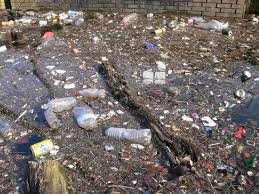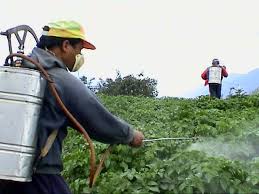INTRODUCTION
Our Earth's surface is 70% water. It is the most precious natural resource that exists in the world. Without water, life on Earth would cease to exist, because everything on our planet needs to grow and prosper. However, even though humans understand that water is vital, we still pollute our oceans, rivers, and lakes. Water Pollution is harming our environment. By the pollution, innocent marine animals are dying at a shockingly high rate. Not only is pollution killing our biosphere's organisms, but the pollution can also affect our drinking water. This first post will talk about how to fight and prevent water pollution, and why we must understand the problems that we are causing by gaining some insight on water pollution. This post will teach you how to stop being the problem, but rather be part of the solution to make this world more sanitary. 
WATER POLLUTION CLASSIFICATIONS (Point and Non-point)
Water pollution can be classified into two different categories. These categories are point and non-point source pollution. Point source pollution can be defined as pollution that comes from a single, identifiable place such as a factory. Sources like business, industry, agricultural, and urban sources can be the factors of such pollution. On the other hand, non-point source pollution comes from land runoff, precipitation, atmospheric deposition, and chemicals that will eventually affect the environment. Usually, nonpoint-source pollution happens when water moves across a piece of land or through the ground, and picks up pollution. This human-made or natural pollutant can be transferred and deposited into nearby lakes, rivers, or coastal waters. The most common nonpoint-source pollutants can vary from sediments and nutrients, to microorganisms and toxics.

HOW TO DETECT POINT AND NON-POINT
Point and non-point source pollution can be detected throughout many different methods. Point source pollution is most commonly detected by a direct visual such as a pipe from a factory dumping sewage into a body of water. Point-source pollutants usually have the highest concentration of pollutants closest to the source, such as a pipe with dirty water. The farther away from point- source pollution, the less concentration of the pollution there is.
Next, non point source pollution is very hard to identify and specify its location. Nonpoint-source pollutants are hard to identify, because the pollution is usually found spread throughout a large area. Many factors can make it challenging to trace the pollution to a single pollutant that originated the pollution. Because non- point source pollution is defined as any pollution that can’t be traced back to a single source, we use monitoring programs such as NOAA’s Mussel Watch Project to better calculate the amount of pollution in a body of water. They go out once every two years and find out how polluted the water is. They then take the total amount of pollution and plug it into a computer, which calculates a model that shows possible relationships and impacts, and methods to prevent the problem.


COMMON CAUSES AND EFFECTS
Water pollution has to come from somewhere, and must have an effect on the habitat; some common causes of water pollution are sewage and fertilizers that contain nitrates and phosphates. Pollutants can come from problems like a pipe that deposes used and dirt water and material from an industrial factory into a body of water. These wastes can be very lethal to the water environment. Also, another cause of water pollution can come from large plantations of agricultural fields. These fields are covered with chemicals such as fertilizers and pesticides, which can run off into nearby streams and rivers, contaminating the water. The river will carry this water into a bigger body of water, therefore contaminating that area. Another cause of water pollution can be due to oil spills of from traveling accidents. The petroleum will harm the environment and pollute the shorelines. This petroleum can damage the aquatic life environment, and possible kill many organisms.
Some effects of water pollution is the ability for proper respiration in aquatic organisms. When chemicals of agricultural fields “run-off” into nearby streams, this causes an abundant amount of algae to grow, and “bloom.” When these algae die, they suck up a great amount of oxygen around them. With many algae blooms, the oxygen of the area will all be sucked up, resulting in a dead zone with no oxygen available. These pollutants can contaminate our water sources, as the appearance becomes less attractive. Also, this water can be very lethal and toxic if drank. If pollution increases within the water, it can easily clog up waterways, and can sometimes cover the water surface, resulting in less sunlight penetration into the water depths.

COMMON MEASURES TO TAKE IF DETECTED
Once detected there are several ways to control a non-point source. One way is to use buffer strips. Buffer strips are strips of grass located between and around impervious paving materials such as parking lots and sidewalks, and a body of water. The buffer strip absorbs soil, fertilizers, pesticides, and other pollutants before they can reach the water. Another way is to use retention ponds, which capture runoff and storm water. Sediments and contaminants settle out of the water when they are trapped in the retention pond. Porous paving materials also help to control the pollution. The porous pavement allows rainwater and storm water to drain into the ground beneath it, reducing runoff. Another method can involve microorganisms to cleanse the water. This process, known as bioremediation, uses organisms to return a contaminated body of water back into its original natural environment. U.S. Geological Survey (USGS) used natural microorganisms to consume the fuel-derived toxic compounds, and transformed it to harmless carbon dioxide.

To prevent as well as the measures to take if detected are very similar in point source pollution. In both cases the effluents of factories are sent to sewage treatment plants. But some factories will treat their own waste before sending it into a body of water. Another way that some factories and sewage treatment plants handle waste material is by mixing it with urban runoff in a combined sewer system. Then the sewage will be treated before released into the environment.
HAZARDOUS AND SERIOUS HEALTH RISKS
With all of this pollution, there come health risks. Some common health risks of non point source pollution such as runoff from storms come from swimming in contaminated waters. Drinking or even swimming in these contaminated waters can cause earaches, sinus problems, diarrhea, fever as well as rashes. Not to mention the health risks of the aquatic life as well. Overall, this pollution can affect all types of life, and cause them to suffer. Many diseases are caused because of polluted waters. Diseases such as cholera, typhoid fever, e-coli infections, PSA infections, diphtheria, and enteric fever are some examples. If the water you drink is not purified, harmful bacteria and viruses can enter your body, which may result in diarrhea and parasites living in your intestines.

PREVENTION METHODS
To prevent the source pollution, there are also several methods. One method is to properly dispose of chemicals. Chemicals cannot be poured down a drain, because they will eventually make their way into a stream or river, where they will harm, and even kill, aquatic life. Another way is to use fertilizers and pesticides sparingly on lawns and gardens. The excess often winds up in runoff and can lead to eutrophication in water bodies. To reduce the use of pesticides, use beneficial insects such as ladybugs and praying mantises to control unwanted pests in the garden. Another very simple way to prevent non-point source pollution is to put trash in its place. Keep it out of storm drains, where it will clog up the drain or end up in the nearest stream or lake.

There are preventions to water pollution, which stops the problem in its tracks as well. In order to prevent water pollution, using non-phosphate and low phosphate detergents can help prevent the threat of having high phosphate levels in streams. If the detergent water runs off into these streams, the phosphate level will not be affected. Also, you ca use a broom instead of water in order to clean your driveway, avoiding sweeping the debris into the sewer. While the walkways are icy, you can use cat litter instead of salt to clean up the ice. Salt pollutes thee water, while killing the plants. Another prevention would be to not dispose of tissues, dead insects, and other animals through the toilet, but through the trashcan.

FACTORS, BELIEFS, AND CONSIDERATIONS ON THE HEALTH OF SOCIETY
The common environmental factors, cultural beliefs and socioeconomic considerations reflected to the health of a society affect how water is received and taken care of as well. The environmental factors related to the health of a society are determined by the location. For example, location of water sources is very important. Here in the United States, we have springs, groundwater, rivers, and lakes. In Africa, due to their location, they have a lack of usable water. They do not have many springs or groundwater, and they bathe and drink in the same water. Not to mention due to their location, the animals bathe and drink from the same water source. Also due to their location, they have frequent droughts, taking the already non-plentiful water.

Their cultural beliefs include not being well educated, and not understanding the needs of water for all people, or water’s benefits. Society is not too hygienic, and focuses on other issues first, priorities are not in order. Their economical and social beliefs also affect this. Third world countries do not have the money for purification systems such as desalinization and reverse osmosis, which help our country thrive. Disease is transmitted to humans from their water, and then the main focus is eliminating the disease, and not the source of the disease- water.



CONCLUSION
Overall, pollution (whether point source or non-point source) can be very damaging to the environment. However, with any environmental problem, there are precautions and measures you can take that will prevent any further damage to the ecosystem. By listening to the proactive measures you can take to prevent water pollution, you cannot only help the environment, but your health and the health of others.


WORKS CITED
Bioremediation: nature's way to a cleaner environment. (1997, April 1). Retrieved from http://water.usgs.gov/wid/html/bioremed.html
Bourgeois, Jeremie (Artist). [Earth Droplet]. Retrieved March 20, 2010, from: http://www.umich.edu/~gs265/society/waterpollution.htm
Diagram of Nonpoint Pollution [Diagram]. Retrieved March 22, 2010, from: http://students.umf.maine.edu/mcgrawbr/public.www/index5.html
Diagram of Nonpoint Pollution [Diagram]. Retrieved March 22, 2010, from: http://students.umf.maine.edu/mcgrawbr/public.www/index5.html
Hannamariah. World Ripples [Picture]. Revived March 15, 2010, from: http://www.shutterstock.com/pic-1409277/stock-photo-earth-map-under-water-ripples-global-warming.html
Lambrecht, William (Photographer). Mississippi River [Photograph]. Retrieved March 22, 2010, from: http://interact.stltoday.com/blogzone/political-fix/dc-download/2009/05/is-obama-stinting-on-water-clean-up-cash-for-mo-ill/
Map of Fresh Water Usage [Map]. Retrieved March 23, 2010, from: http://www.mapsofworld.com/images/world-top-ten-countries/world-top-ten-fresh-water-supply-map.gif
Non point source pollution: Categories of Pollution Non Point Source. (2008, March 25). Retrieved from http://oceanservice.noaa.gov/education/kits/pollution/04nonpointsourc
es.html
Non point source pollution: Categories of Pollution: Point Source. (2008, March 25). Retrieved from http://oceanservice.noaa.gov/education/kits/pollution/03pointsource.html
Non point source pollution: Research, Monitoring, and Assessment. (2008, March 25). Retrieved from http://oceanservice.noaa.gov/education/kits/pollution/014research.html
es.html
Non point source pollution: Categories of Pollution: Point Source. (2008, March 25). Retrieved from http://oceanservice.noaa.gov/education/kits/pollution/03pointsource.html
Non point source pollution: Research, Monitoring, and Assessment. (2008, March 25). Retrieved from http://oceanservice.noaa.gov/education/kits/pollution/014research.html
Parasitism [Photograph]. Retrieved March 17, 2010, from: http://www.squidoo.com/get-rid-of-intestinal-parasites
Point-Solution Pipe [Picture]. Retrieved March 17, 2010, From: http://www.waterencyclopedia.com/images/wsci_03_img0431.jpg
Thurman, Gerald D. (Photographer). Don't Litter Sign [Photograph]. Retrieved March 15, 2010, from: http://www.azlitter.org/20050401/images/01_DontLitterSign.jpg
Water Contamination [Photograph]. (2009). Retrieved March 19, 2010, from: http://www.paranormalknowledge.com/articles/wp-content/uploads/2008/12/waterpollution.jpg
Water pollution solution. (n.d.). Retrieved from http://www.greenbelt.org/downloads/resources/curriculum/chapter4.pdf
Winter-hart, Nicole (Photographer). Nepalese Child in Dirty Water [Picture]. Revived March 20, 2010, from: http://www.pledgingforchange.com/profiles/profile/show?id=Nicolewinterhart

No comments:
Post a Comment